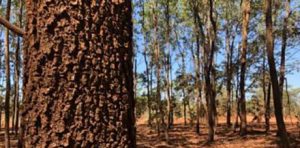A Cooperative Research Centre for Developing Northern Australia (CRCNA) study has identified the Northern Australian forestry and forest products industry could potentially treble its production value to up to $300 million per annum and create 600 new jobs over the next five to 10 years. Source: Timberbiz
The report found the sector could make these increases through the sustainable management of northern forestry areas for timber harvesting and within a framework which conserves the natural values of the forest.
The Northern forestry and forest products industry situational analysis is the result of a collaboration between the CRCNA, Timber Queensland (TQ), the Northern Territory Department of Primary Industry and Resources (NT DPIR), Queensland Department of Agriculture and Fisheries (DAF) and the University of the Sunshine Coast (USC).
Timber Queensland’s CEO Mick Stephens said the project identified the industry supports around 1200 direct jobs with an annual production value of over $80 million.
“Importantly, key sectors of the industry have until now been largely based on establishing the underlying plantation forest resources of around 100,000 hectares for downstream processing and export markets,” Mr Stephens said.
“This is the case for the maturing plantation forest resources of African Mahogany, Indian sandalwood and Acacia, that are now approaching or only recently transitioning to harvest age and sale into markets. The exception is the softwood plantation estate in Far North Queensland, which already supplies into domestic sawmilling and building markets with good scope for expansion.
“With forecast increases in demand for forest products both domestically and globally, the industry is poised to take advantage of growing Asian and domestic markets for a range of plantation wood fibre and timber products,” he said.
A significant opportunity also revolved around the development of indigenous native forestry, with 73% of the forests in Northern Australia under indigenous ownership or management. Northern Australia has 63 million hectares of native forest, with 13 million hectares identified as having commercial timber potential.
“To make good on these prospects, the analysis shows government and industry must focus on removing barriers for downstream processing and value-adding for forest product and timber markets – and addressing barriers to new plantation investment,’’ Mr Stephens said.
Mr Stephens said the study recommends six key actions that can deliver future industry growth:
- Build on the newly formed industry and cross-jurisdictional agency alliance to promote forest sector development across Northern Australia.
- Promote indigenous forestry development through better engagement models and commercial arrangements between industry and indigenous landowners, and build indigenous forestry capacity and understanding of commercial forest resources, including forest resource inventory.
- Develop secure access arrangements for supply from crown native forest land (i.e. leasehold) in northern Queensland.
- Develop a market research study into the potential supply and demand for wood products from Northern Australia, including key markets and supply chain needs (e.g. regional infrastructure).
- Assess silvopastoral opportunities (i.e. integrated forestry and livestock production) as a vehicle for new commercial tree plantings
- Review Emissions Reduction Fund (ERF) barriers to carbon market access for forestry activities, with priority on the ‘water rule’ requirement for new plantations.
CRCNA CEO Jed Matz said the project reviewed the potential policy, investment and other solutions to barriers preventing industry development and identified strategic research projects for further investment.
“Timber Queensland and their industry and research partners have developed a strong set of recommendations which will deliver a pathway for realising forest industry potential in Northern Australia,” he said.
Project partners Forest Products Commission Western Australia, Plantation Management Partners, Midway, HQPlantations, Ravenshoe Timber, DTM Timber/Branch 95, Quintis and Alpha Santanol, have established an Industry Development Alliance which includes several relevant state departments, industry bodies and research providers.
“This alliance will help ensure researchers and policymakers prioritise the development and growth of the forest products industry in Northern Australia, and the CRCNA is pleased to be a stakeholder to facilitate well-targeted R&D for further industry growth,” Mr Matz said.
The CRCNA’s Northern forest and forest products industry situational analysis project is one of five industry situational analyses currently funded by the CRCNA examining the aquaculture, rice, cropping, beef, health and communication sectors.
The report is at https://www.crcna.com.au/sites/default/files/2020-04/FINAL_CRCNA%20NA%20Forestry%20SA_April%202020-%20amended.pdf






